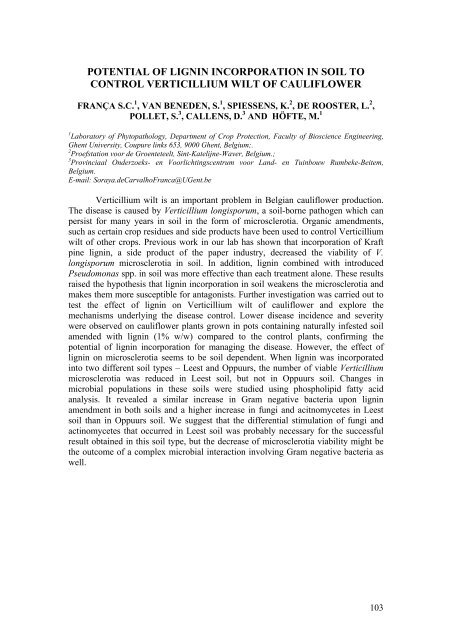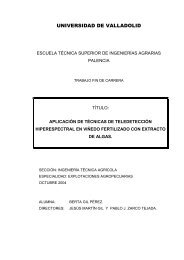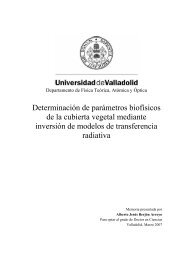10th INTERNATIONAL VERTICILLIUM SYMPOSIUM 16-20 ...
10th INTERNATIONAL VERTICILLIUM SYMPOSIUM 16-20 ...
10th INTERNATIONAL VERTICILLIUM SYMPOSIUM 16-20 ...
You also want an ePaper? Increase the reach of your titles
YUMPU automatically turns print PDFs into web optimized ePapers that Google loves.
POTENTIAL OF LIGNIN INCORPORATION IN SOIL TOCONTROL <strong>VERTICILLIUM</strong> WILT OF CAULIFLOWERFRANÇA S.C. 1 , VAN BENEDEN, S. 1 , SPIESSENS, K. 2 , DE ROOSTER, L. 2 ,POLLET, S. 3 , CALLENS, D. 3 AND HÖFTE, M. 11 Laboratory of Phytopathology, Department of Crop Protection, Faculty of Bioscience Engineering,Ghent University, Coupure links 653, 9000 Ghent, Belgium;.2 Proefstation voor de Groenteteelt, Sint-Katelijne-Waver, Belgium.;3 Provinciaal Onderzoeks- en Voorlichtingscentrum voor Land- en Tuinbouw Rumbeke-Beitem,Belgium.E-mail: Soraya.deCarvalhoFranca@UGent.beVerticillium wilt is an important problem in Belgian cauliflower production.The disease is caused by Verticillium longisporum, a soil-borne pathogen which canpersist for many years in soil in the form of microsclerotia. Organic amendments,such as certain crop residues and side products have been used to control Verticilliumwilt of other crops. Previous work in our lab has shown that incorporation of Kraftpine lignin, a side product of the paper industry, decreased the viability of V.longisporum microsclerotia in soil. In addition, lignin combined with introducedPseudomonas spp. in soil was more effective than each treatment alone. These resultsraised the hypothesis that lignin incorporation in soil weakens the microsclerotia andmakes them more susceptible for antagonists. Further investigation was carried out totest the effect of lignin on Verticillium wilt of cauliflower and explore themechanisms underlying the disease control. Lower disease incidence and severitywere observed on cauliflower plants grown in pots containing naturally infested soilamended with lignin (1% w/w) compared to the control plants, confirming thepotential of lignin incorporation for managing the disease. However, the effect oflignin on microsclerotia seems to be soil dependent. When lignin was incorporatedinto two different soil types – Leest and Oppuurs, the number of viable Verticilliummicrosclerotia was reduced in Leest soil, but not in Oppuurs soil. Changes inmicrobial populations in these soils were studied using phospholipid fatty acidanalysis. It revealed a similar increase in Gram negative bacteria upon ligninamendment in both soils and a higher increase in fungi and acitnomycetes in Leestsoil than in Oppuurs soil. We suggest that the differential stimulation of fungi andactinomycetes that occurred in Leest soil was probably necessary for the successfulresult obtained in this soil type, but the decrease of microsclerotia viability might bethe outcome of a complex microbial interaction involving Gram negative bacteria aswell.103




